

The BMW R GS Basic and Kalahari
The Airhead is still alive

 |
 |
The BMW R GS Basic and KalahariThe Airhead is still alive |
 |
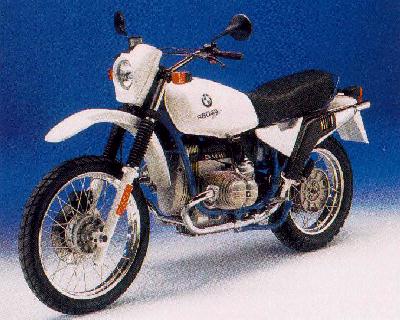
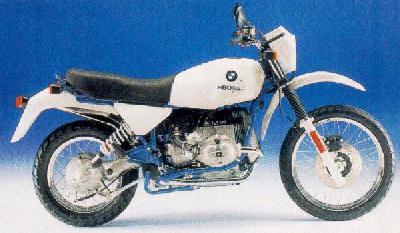
From the death of the 2 valves boxer, some news about a future "last version" bike with this engine appear time to time. Now it's reality.
The R 80 GS Basic is a like a '87-90 R 80 GS with high fender, a White Power rear shock, the G/S seat and the G/S (19,5 lit./5,1 gal.) tank with modern aero-plug. It's weight is 209 kg. The frame and the center stand is painted blue; the tank, cockpit and fenders are white. The rear suspension is the paralever. It's available from June '96 and the Price in Germany is 15.500,-DM.
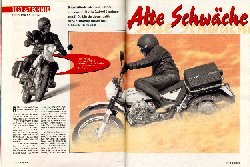
The Old "Soft Spot" (Lit: "Schwaeche" - -weakness-)
Having bid farewell several times already to the "Last Edition Models", here is yet another two-valve boxer. .. A blessing for those who still have a weakness for this venerable but respected powerplant.
BMW has provided us with the ultimate proof: there really is life after death! The proof of this phenomenon sits there on two wire wheels, painted in the traditional white & blue, and and is powered by an "Old Guard" Boxer. That spirit which used to bear names like R 80 G/S or R 80 GS has been reincarnated as the R 80 GS Basic and still enjoys the best of health.
Now this "resurrection" is not creating a world-wide commotion, since the Bavarians have used the possibility of yet another two-valve BMW variation to snare their loyal customers for the last several years. And acording to the slogan: "You'd better get it; it's the last one", there will certainly be plenty of customers for this special model. A good trick, and one that the clever Bavarians have used with some regularity.
Perhaps this time things are different. Perhaps in the year of the IFMA show it was necessary to clean out one or another of the warehouses in order to make room for the long-awaited new arrivals from BMW. And instead of selling off all the old spare parts that have been accumulated over decades a few parts at a atime, the Bavarians thought of a cleverer way to dispose of all this aggregated obsolescence. Why not just take something from every model series, put it together in a complete motorcycle, and then bring it to the grateful multitudes for a mere 15,959 Marks (about $10,500).
No sooner said than done... the motor is taken from the 798 cc drivetrain used until 1994 in the R 80 GS. This series is upgraded with the round valve covers dating back to 1969 and the first /5 series, which also decorated the cylinder heads of the R 100 Classic and R 100 GS Paris/Dakar - both promoted in 1995 as the ultimate last two-valve Boxer models. With 50 horsepower the Basic remains true to the old GS versions. Obviously, the Paralever swingarm, which revolutionized suspension contruction at BMW in 1987, is used.
Further back in the racks they found a little 19.5 liter gastank that fitted. It won't bother anyone that this tank used to fit the street-version R 80 ST. On the contrary, this tank saves the weight of the 6.5 liters of gasoline that the actual GS tank would have held... Still older by three years is the little headlight nacelle with the integrated speedometer housing. Since there is no tachometer, there are little marks on the speedometer face to indicate the maximum speeds in all five gears, to protect the valve train from over-revs.
RIDING IMPRESSION OF THE R 80 GS Basic
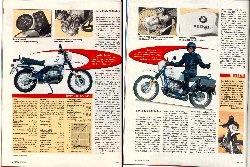
The rear shock is contemporary, built specially for the Basic by White Power. In front, the springing and damping is provided by a Marzocchi telescopic fork, in the manner which it has done since 1987 - totally comfortably.
Comfort is also the overall impression which the exceptionally good-natured and agile Basic makes from the first test ride. The extremely low seat height, in comparison to the contemporary R 1100 GS, conveys security, the high, wide handlebar provides a relaxed, upright riding position. Thanks to the low center of gravity the 218 kilogram (479 lbs.), weight of the fully-gassed Basic is scarcely noticeable. It is true that the unfortunate angular step between the tank and the seat interferes a little with the enjoyment of long rides, still the main impression is of stress-free relaxation. This "Old Lady" can still fly over the secondary roads, and the worse the pavement, the better she handles it. Both front and rear suspension protect the rider from all disturbing influences, yet react softly and sensitively without feeling mushy (lit. "doughy").
The narrow enduro tires provide very positive effect, especially on such curvy roads. No wiggling in bumpy curves, barely any tendency to stand up and run wide when braking while leaned over, and even at full throttle flat-out running on the autobahn at 170 kph (105 + mph) the weaving (a familiar characteristic of GS's at high speeds - kwp) remains within bearable limits.
Not so superior is the performance of the ancient front brake. With middling effect, the single 285mm disc and two-piston caliper is already overtaxed with the weight of rider and passenger. When saddled with the burden of a passenger and fully loaded saddlebags (as are offered in the accessory catalog), the brakes give up completely. Two or three hard brake applications for the critical hairpins of an alpine pass descent is sufficient to bring the brake lever completely back to the twistgrip without resistance. In this event all one can do is trust in the rear drum brake, less efficient but more reliable in its effect. Nostalgia or not, here is an area where BMW should not have relied on such old junk, but as with the (Paralever) swingarm should have paid more attention to functionality.
 |
Motorrad, June 22, 1996, Issue 14 (ISSN 0027-237 X E4973D) By Gerhard Lindner. Photos by Achim Hartmann Address: Motorrad, Leserservice, 20080 Hamburg, Germany. |
Translated on 6.26.96, by Kari Prager
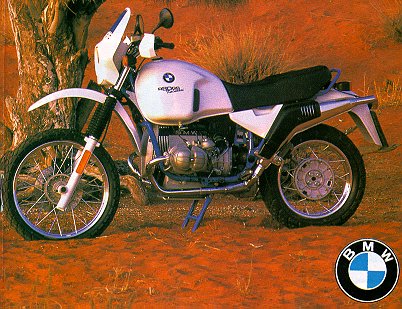
The 5 September in a mail to the BMW -GS motorcycles mailing list, Lodewyk Steyn give us some information about a new "old" GS version :
I've got a bit of information I would like to share with the readers of BMW-GS.
Early in August this year (1997) a new model of the old model GS was launched in South Africa. Known as the R 80 GS Kalahari, it originates from the R 80 GS Basic available in Europe. It is white in colour with a blue frame.
The following is a description of what the motorcycle looks like: Round headlight with old instrument cluster as found on early model GS's and G/S's. Small windscreen. High front mudguard with Marzocchi front forks. White Power rear suspension. Early model 35 liter Paris Dakar petrol tank made of steel. No crashbars or sidestand. The rear subframe is the same as that of the first G/S's with the lugage rack at the back as an optional extra that bolt on. Paralever suspension. R 80 GS Kalahari decals. The old reliable 798cc aircooled boxer engine is used.
The model is currently only produced for the South African market but there is rumours that it might also be available elsewhere.
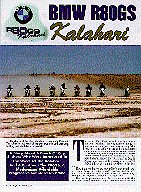 R 80 GS Kalahari
R 80 GS KalahariA story about a bunch of city slickers who were intriduced to the way of the Kalahari. And a bit about the R 80 GS, a modernised affordable progressive simple retro BMW.
The name "Hari Kari" would have been more apt than "Kalahari" the way some of the guys bounced and hopped their way through the road test. The area was around the Kalahari Geinsbok Park, with our base the Motel Molopo at Andriesvale, also a stopover for the annual Easter Namib Desert Run. The bikes were the new BMW'S, named the "Kalahari" in South Africa, a revamp of the original late 1970'S R 80 GS into what it should have been in the first place.
They took the legendary and reliable and tough and everlasting boxer two valve twin GS, first launched in 1978, and did to it what many had done to theirs at home - they changed the suspension and put on a bigger tank.
The best improvement was the suspension with the front end getting motocross type Marzocchi forks and the rear a White Power shock with Paralever drive shaft. This transforms the bike from a good road bike and an adequate offroader to a better of both. The bike can now hit potholes and ditches and objects of destruction without denting rims and sending shock waves to the rider. I have been riding BM's on the annual Easter Desert run for 16 years, each year bending the bike less and less as home made improvements to the suspension were made and suddenly in one hit BMW do it all with this Kalahari. Where were you, I asked, in all those years when 1 needed you.
I now also have a new R 1100 GS (no, don't phone, I'm not selling the old one) but it is heavier, albeit much more powerful, especially with the RS motor. And in low speed sandy conditions I'd rather have the lighter R 80. Or, better still, this R 80 with a 1000cc uprated motor, but we'Il probably have to wait another 18 years for that.
Other changes include a big Paris Dakar tank, which completely transforme the bike visually and makes it look the part, and wider wheels, with the new system where the spokes attach te the rim outside the tyre rim, allowing tubeless tyres to be used and making spoke adjusting possible without removing the tyre. The seat height, despite the better suspension, is actually lower, which is great news for those who paddle their way through sand and up cliffs and things.

On the first day we did the 170km of fairly straightforward hardish dirt road to Van Zylsrus and then 200km along the Botswana border on the Molopo riverbed back to the hotel. It was an excellent route for testing the bikes, with a mixture of terrain.
On the fast bit the speedo ran to 160km/hr, 15km/hr slower than on tar. And it required a longish stretch of hard road to get there, with sandy bits sending the rear into the famous BMW waggle and reducing speed.
The "waggle" is what a BMW does at speed on dirt, and it involves mostly the rear wheel - it just does not follow the front but hops from side to side. This trait should be ignored by the rider. The bike, with its low engine mass, solid engineering and stable geometry, would stay upright and go mostly in the direction the rider intended it to go, safely and, believe it or not, accurately. Once the guys realised this, they became more relaxed and more confident with the throttle and lived with the waltz that gives an idescribably exhilarating high.
There were some F650's along and the comparisons were interesting. The F650 is a dffferent bike altogether, aimed at those who want a smaller, lighter bike. The 800 is bigger, more solid, more comfortable and more motorcycle.
Off road the F650 is easier to handle, being lighter. It is especially better on sandy bends from where it can accelerate away faster while the 800 takes longer to get up to speed again. With agressive riding of both, there is not much dffference between the two. On the pans where the top layer crust was thin and breaking to make the going soft, the 650 was definately better, getting up and out of the softness better while the 800 was held back more. But neither are very good at negotiating soft desert or dune sand at low speeds.

On tar we did some interesting top gear roll-ons. We rode side by side and then wacked open the throttle from various speeds. From 60km/hr in top the 800 convincingly pulled away from the 650, from 80km/hr the difference was less and from 100km/hr the roles were reversed and the 650 was quicker away and even quicker at 120.
Top speed was similar, with the speedos at around 180. With slipstreaming the one could pass the other only to be repassed as the other tucked into the slipstream and eased past. There was much of this (and other acts of hooliganism) going on during the 200km trip from Andriesvale to the airport at Upington. BMW's two new Lifestyle Centres recruits - Colin Howell of Midrand and Gary Whitehouse of Durban were also there, and both happen to be seasoned enduro riders, as was Michel Lupini of Style magazine, which added spice to any dice. And surprise speedsters were Paul Shippey of Wiel and Ian Shrosbee of Topcar and, although with a lot less hooligan element in his riding, ex rally star Peter De Waal, now head of a department at BMW. He had become keen on biking a few months before on a tar excursion but by the end of this lot was worse hooked than a recently reborn happy clappy, and preached his enthusiasm to all and sundry. Lekker, Peter. We'Il see much more of you on the road or trail. Others there were, each deserving a mention, but none more than the late Barry Broady, the BMW motorcycle manager. We don't write obituaries in Bike SA, but all will miss the man plenty.
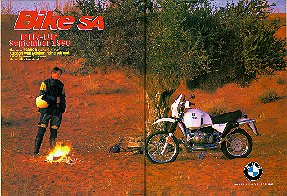
The R 80 also did some heavy rock work, as seen in the photos. At the edge of one pan there was a sharp, rocky incline leading up to some picturesque cliffs. With much un-BMWlike footup observed trials riding (and thanks to Gary Whitehouses paddling with long legs) we got some bikes to the top. The torque is lovely and with momentum a BMW is a more than adequate trials bike.
Impact punctures on rocks are a problem with underinflated tyres though, as Michel (renamed 'Roeky') Lupini found out after getting one.
Falloffs were mostly of the slow, humorous variety and the fast stuff claimed only one casualty. After Colin Howell had spent many happy hours with the throttle cable stretched, a bend eventually did catch him out. It was an unexpectedlv sharp left hander after many-kilometres of fast sweeping bends. Colin did the usual rolling back of the throttle into the bend and rolled it on to power out of what he thought was a fast sweep. It was a sharp bend and he was a few gears too high and going several dozen kilometres an hour too fast. He broadsided across the road and flew into and over the opposite bank to record the fastest prang of the trip. The Iast time I looked he was still employed at BMW in Midrand so his episode was not among the firing category of misdeeds in the BMW code of conduct manual.
A really nice bike was almost everyone's conclusion. At R50000 it is affordable and the basic bike has proved its worth after 17 very successful years on the market. It is now upgraded in all the right places and should provide good on and off road ridin to owners for as long as they are likely to ride.
 |
Bike SA, September, 1996 Address: Bike SA, Box 894, 2000 Johannesbourg, South Africa. |
Updated 29 March 2004